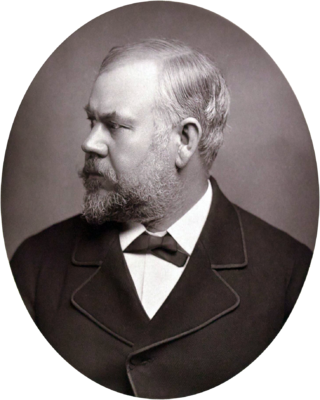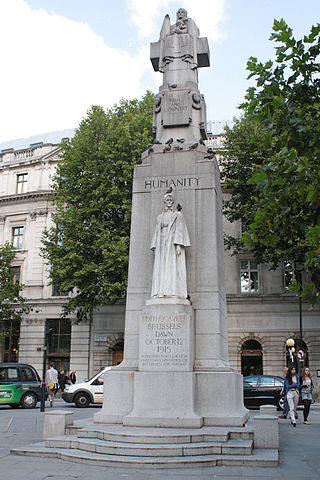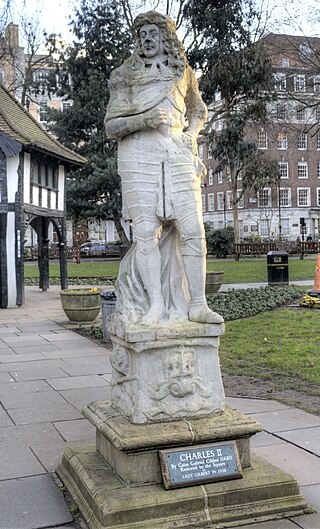
Nelson's Column is a monument in Trafalgar Square in the City of Westminster, Central London, built to commemorate Vice-Admiral Horatio Nelson's decisive victory at the Battle of Trafalgar over the combined French and Spanish navies, during which he was killed by a French sniper. The monument was constructed between 1840 and 1843 to a design by William Railton at a cost of £47,000. It is a column of the Corinthian order built from Dartmoor granite. The statue of Nelson was carved from Craigleith sandstone by sculptor Edward Hodges Baily. The four bronze lions around its base, designed by Sir Edwin Landseer, were added in 1867.

The Albert Memorial, directly north of the Royal Albert Hall in Kensington Gardens, London, was commissioned by Queen Victoria in memory of her beloved husband Prince Albert, who died in 1861. Designed by Sir George Gilbert Scott in the Gothic Revival style, it takes the form of an ornate canopy or pavilion 176 feet (54 m) tall, in the style of a Gothic ciborium over the high altar of a church, sheltering a statue of the prince facing south. It took over ten years to complete, the £120,000 cost met by public subscription.

Temple Bar was the principal ceremonial entrance to the City of London from the City of Westminster. In the Middle Ages, London expanded city jurisdiction beyond its walls to gates, called 'bars', which were erected across thoroughfares. To the west of the City of London, the bar was located adjacent to the area known as the Temple. Temple Bar was situated on the historic royal ceremonial route from the Tower of London to the Palace of Westminster, the two chief residences of the medieval English monarchs, and from the Palace of Westminster to St Paul's Cathedral. The road east of the bar within the city was Fleet Street, while the road to the west, in Westminster, was The Strand.

Henry Hugh Armstead was an English sculptor and illustrator, influenced by the Pre-Raphaelites.

William Calder Marshall ARSA was a Scottish sculptor.

Francis Bird (1667–1731) was one of the leading English sculptors of his time. He is mainly remembered for sculptures in Westminster Abbey and St Paul's Cathedral. He carved a tomb for the dramatist William Congreve in Westminster Abbey and sculptures of the apostles and evangelists on the exterior of St Paul's, a memorial to William Hewer in the interior of St Paul's Church, Clapham as well as the statue of Henry VI in School Yard, Eton College. Despite his success, later in life Bird did little sculpting. He had inherited money from his father-in-law and set up a marble import business.

Matthew Cotes Wyatt was an English painter and sculptor and a member of the Wyatt family, who were well known in the Victorian era as architects and sculptors.

William Shakespeare has been commemorated in a number of different statues and memorials around the world, notably his funerary monument in Stratford-upon-Avon ; a statue in Poets' Corner in Westminster Abbey, London, designed by William Kent and executed by Peter Scheemakers (1740); and a statue in New York's Central Park by John Quincy Adams Ward (1872).

Richard Coeur de Lion is a Grade II listed equestrian statue of the 12th-century English monarch Richard I, also known as Richard the Lionheart, who reigned from 1189 to 1199. It stands on a granite pedestal in Old Palace Yard outside the Palace of Westminster in London, facing south towards the entrance to the House of Lords. It was created by Baron Carlo Marochetti, an Italian sculptor whose works were popular with European royalty and the nobility, though often less well regarded by critics and the artistic establishment. The statue was first produced in clay and displayed at The Great Exhibition in 1851, where it was located outside the west entrance to the Crystal Palace. It was well received at the time and two years later Queen Victoria and Prince Albert headed a list of illustrious subscribers to a fund that aimed to raise money for the casting of the statue in bronze.

The Statue of Queen Victoria stands in front of Chester Crown Court in the forecourt of Chester Castle, Chester, Cheshire, England. It was unveiled in 1903, the sculptor was Frederick William Pomeroy, and the statue is recorded in the National Heritage List for England as a designated Grade II listed building.

The Statue of Edward VII stands in Kings's Gardens, Stanley Road, Bootle, Sefton, Merseyside, England. It was erected to commemorate the Coronation of King Edward VII and consists of a bronze statue of Edward VII on a granite pedestal. The sculptor was George Wade. The statue was given to the borough by the local Member of Parliament, and stands on land given to the borough by Lord Derby. It was unveiled by Lady Derby in 1904.

A Memorial to Queen Victoria stands in Woodhouse Moor, Leeds, West Yorkshire, England.

A statue of William Shakespeare, by the sculptor Giovanni Fontana after an original by Peter Scheemakers, has formed the centrepiece of Leicester Square Gardens in London since 1874.

The Edith Cavell Memorial is an outdoor memorial to Edith Cavell by Sir George Frampton, in London, United Kingdom. The memorial is sited in St Martin's Place, beside the A400, just outside the northeast corner of Trafalgar Square, north of St Martin-in-the-Fields, east of the National Gallery and the National Portrait Gallery, and south of the London Coliseum. The site is adjacent to the first headquarters of the British Red Cross, originally located at 7 St Martin's Place.

The statue of Charles II is an outdoor sculpture of Charles II of England by the Danish sculptor Caius Gabriel Cibber, located near the centre of Soho Square in London. Once part of a late 17th century fountain, it was removed in the late 19th century to a private estate in Harrow before being restored to the square in the mid-20th century. It depicts the king in a standing pose on top of a low decorated pedestal. Although it has been the subject of restoration works, it is heavily eroded and in a poor condition.

A bronze statue of Isambard Kingdom Brunel, also known as Brunel Monument or the Isambard Brunel Monument, by Carlo Marochetti, stands on the Victoria Embankment in London, England, at the west end of Temple Place. The statue rests on a Portland stone pedestal, with flanking screens and benches, by the architect Richard Norman Shaw.

A statue of Queen Anne is installed in the forecourt outside the west front of St Paul's Cathedral, in London, United Kingdom. It became a Grade II listed building in 1972.

The statue of William Slim, 1st Viscount Slim in Whitehall, London, is a work of 1988–1993 by the sculptor Ivor Roberts-Jones. It is one of three memorials to British military leaders of World War II on Raleigh Green, outside the Ministry of Defence's Main Building, the others being Oscar Nemon's 1980 statue of Lord Montgomery and Roberts-Jones's statue of Lord Alanbrooke, erected later in 1993. Slim's bronze statue stands approximately 3 metres (9.8 ft) high on a pedestal of Portland stone.

The statue of Charles James Fox stands at the north end of Bloomsbury Square in the London borough of Camden. Erected in 1816, the sculptor was Richard Westmacott. It commemorates the Whig politician who died in 1806. Fox is shown in the garb of a Roman senator. The statue is a Grade II* listed structure.

The Jubilee Memorial, Harrogate, is a Grade II listed building. It is a Gothic Revival stone memorial in Harrogate, North Yorkshire, England, commemorating the 1887 golden jubilee of Queen Victoria. It was donated to Harrogate by its mayor, Richard Ellis, designed by architect Arthur Bown, and unveiled by the Marquis of Ripon.






















